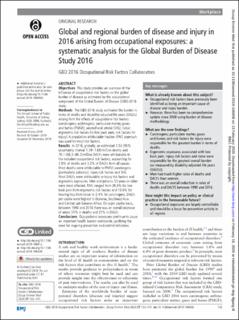| dc.contributor.author | Kisa, Adnan | |
| dc.contributor.author | Driscoll, Tim R. | |
| dc.contributor.author | Rushton, Lesley | |
| dc.contributor.author | Hutchings, Sally J. | |
| dc.contributor.author | Straif, Kurt | |
| dc.contributor.author | Steenland, Kyle | |
| dc.contributor.author | Abate, Degu | |
| dc.contributor.author | Winkler, Andrea Sylvia | |
| dc.date.accessioned | 2022-10-27T16:05:56Z | |
| dc.date.available | 2022-10-27T16:05:56Z | |
| dc.date.created | 2020-02-16T16:26:41Z | |
| dc.date.issued | 2020 | |
| dc.identifier.citation | Occupational and environmental medicine, 77(3), 133–141. | en_US |
| dc.identifier.issn | 1351-0711 | |
| dc.identifier.uri | https://hdl.handle.net/11250/3028704 | |
| dc.description.abstract | Objectives This study provides an overview of the influence of occupational risk factors on the global burden of disease as estimated by the occupational component of the Global Burden of Disease (GBD) 2016 study. Methods The GBD 2016 study estimated the burden in terms of deaths and disability-adjusted life years (DALYs) arising from the effects of occupational risk factors (carcinogens; asthmagens; particulate matter, gases and fumes (PMGF); secondhand smoke (SHS); noise; ergonomic risk factors for low back pain; risk factors for injury). A population attributable fraction (PAF) approach was used for most risk factors. Results In 2016, globally, an estimated 1.53 (95% uncertainty interval 1.39–1.68) million deaths and 76.1 (66.3–86.3) million DALYs were attributable to the included occupational risk factors, accounting for 2.8% of deaths and 3.2% of DALYs from all causes. Most deaths were attributable to PMGF, carcinogens (particularly asbestos), injury risk factors and SHS. Most DALYs were attributable to injury risk factors and ergonomic exposures. Men and persons 55 years or older were most affected. PAFs ranged from 26.8% for low back pain from ergonomic risk factors and 19.6% for hearing loss from noise to 3.4% for carcinogens. DALYs per capita were highest in Oceania, Southeast Asia and Central sub-S aharan Africa. On a per capita basis, between 1990 and 2016 there was an overall decrease of about 31% in deaths and 25% in DALYs. Conclusions Occupational exposures continue to cause an important health burden worldwide, justifying the need for ongoing prevention and control initiatives. | en_US |
| dc.description.sponsorship | BPAQ acknowledges the institutional support of PRONABEC (National Program of Scholarship and Educational Loan), provided by the Peruvian Government; and the Judith Lumley Centre of La Trobe University. Till Winfried Bärnighausen was supported by the Alexander von Humboldt Foundation through the Alexander von Humboldt Professor Award, funded by the Federal
Ministry of Education and Research, Germany. Félix Carvalho acknowledges UID/ MULTI/04378/2019 support with funding from FCT/MCTES through national funds. Eduarda Fernandes acknowledges UID/QUI/50006/2019 support with funding from
FCT/MCTES through national funds. Mihajlo Jakovljevic acknowledges that the Serbian part of this GBD contribution was cofinanced through Grant OI 175 014 of the Ministry of Education, Science and Technological Development of the Republic of
Serbia. Yun Jin Kim was supported by the Office of Research and Innovation, Xiamen University Malaysia. Walter Mendoza is currently a program analyst for Population and Development at the Peru Country Office of the United Nations Population Fund UNFPA, an institution which does not necessarily endorse this study. MMolokhia was supported by the National Institute for Health Research (NIHR) Biomedical Research Centre at Guy’s and St Thomas’ NHS Foundation Trust and King’s College
London. Abdallah M Samy received a fellowship from the Egyptian Fulbright Mission Program (EFMP). SMSI is funded by a Senior Research Fellowship from the Institute for Physical Activity and Nutrition (IPAN), Deakin University. RT-S was supported
in part by grant number PROMETEOII/2015/021 from Generalitat Valenciana and the national grant PI17/00719 from ISCIII-FEDER. Paul Yip was supported by the Strategic Public Policy Research (SPPR) grant (HKU-12). | en_US |
| dc.language.iso | eng | en_US |
| dc.relation.uri | https://oem.bmj.com/content/77/3/133 | |
| dc.rights | Navngivelse-DelPåSammeVilkår 4.0 Internasjonal | * |
| dc.rights.uri | http://creativecommons.org/licenses/by-sa/4.0/deed.no | * |
| dc.subject | yrkesskade | en_US |
| dc.subject | global burden of disease | en_US |
| dc.subject | sykdomsbyrde | en_US |
| dc.title | Global and regional burden of disease and injury in 2016 arising from occupational exposures: a systematic analysis for the Global Burden of Disease Study 2016 | en_US |
| dc.type | Peer reviewed | en_US |
| dc.type | Journal article | en_US |
| dc.description.version | publishedVersion | en_US |
| dc.source.pagenumber | 133-141 | en_US |
| dc.source.volume | 77 | en_US |
| dc.source.journal | Occupational and Environmental Medicine | en_US |
| dc.source.issue | 3 | en_US |
| dc.identifier.doi | 10.1136/oemed-2019-106008 | |
| dc.identifier.cristin | 1794487 | |
| cristin.unitcode | 1615,40,10,0 | |
| cristin.unitname | Institutt for helsevitenskap | |
| cristin.ispublished | true | |
| cristin.fulltext | original | |
| cristin.qualitycode | 2 | |

